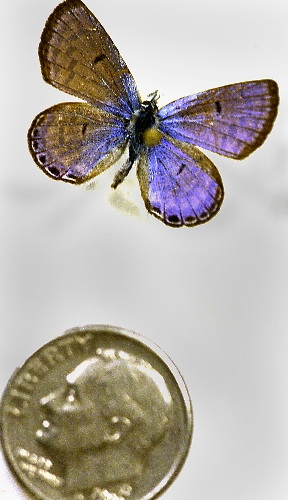Decision to keep Nevada butterflies off endangered list called ‘fiasco’
They're barely bigger than a dime, but the Mount Charleston blue butterflies -- all 18 of them -- might be making their last flutter in the Spring Mountains or anywhere else on Earth, observers who sought federal protection for them said Tuesday.
"I'm really heartbroken about it. It's not looking real good," Rob Mrowka of the Center for Biological Diversity said about the U.S. Fish and Wildlife Service's finding this week that the imperiled iridescent blue butterfly warrants protection but won't receive it. That's because it's only a subspecies of Shasta blue butterflies and there are higher priorities for listing other critters on the brink of extinction.
"Just random weather events could push that species over the top," said Mrowka, a Las Vegas spokesman for the center, an environmental watchdog group.
The center accused the Fish and Wildlife Service of foot dragging in a lawsuit last year because it failed to act quickly enough on a 2005 petition by Urban Wildlands Group Inc. to list the Mount Charleston blue butterfly as a threatened or endangered species.
Bruce Boyd, a butterfly expert from Henderson whose work was cited in the 65-page finding, was upset that instead of listing the Mount Charleston blue, the service chose instead to include it with about 200 other candidates for listing. A candidate, however, doesn't require the Fish and Wildlife Service to make any change in its level of protection.
"It's a fiasco," Boyd said . "An extinct species is much easier to manage, and it won't interfere with anybody's vacation days."
He cited another rare Spring Mountains butterfly, Morand's checkerspot, for which he drafted a petition for listing that apparently has fallen on the back burner.
"It details how ignorance, politics and personal agendas influence projects created to protect Nevada's natural history," Boyd wrote in an e-mail.
Jill Ralston, the Fish and Wildlife Service's deputy field supervisor for Nevada, defended the agency's finding, saying that despite a survey last year that turned up only 18 blue butterflies on the mountain, she doesn't think it's the end of the road for the subspecies. She said her staff is working with the Forest Service to conserve habitat for the blue butterfly and other species.
"We're not going to be walking away from this," Ralston said. If surveys this summer show a decline in numbers, "then we'll take further action, which would most likely be emergency listing."
As it stands nationwide, the workload and cost of listing species have left the blue butterfly shortchanged. The Fish and Wildlife Service said it costs almost $790,000 to publish findings, listings and decision documents for each candidate.
Blue butterfly caterpillars have the ability to lie dormant through one or possibly more seasons. Their survival depends on its larval host plant, Torrey's milkvetch, a small, low-growing herb that prefers open areas at elevations between 5,000 feet and 10,800 feet.
Since the blue butterfly was first documented on Mount Charleston in 1928, it has been recorded off and on at 15 locations, with the last significant sightings at some of those locations in 1995. In the July 2010 survey, it was found at two locations: a wilderness area along the South Loop Trail, where 17 were sighted, and at the Las Vegas Ski & Snowboard Resort in Lee Canyon, where a single adult blue butterfly was observed.
A colony appears to surviving in the wilderness area, which is protected from development and heavy use, but its numbers are dwindling at the ski resort, where the removal of trees and shrubs for runs has allowed non-native plants to overtake habitat for the butterfly's host plant, the report said.
Critics say wildfire suppression efforts by the Forest Service also have taken a toll on habitat favorable to blue butterflies. Attempts to correct that by thinning trees have backfired because chippers were used to dispose of cut trees, and the chips were spread on top of soil vital to the butterfly's life cycle.
Contact reporter Keith Rogers at krogers@reviewjournal.com or 702-383-0308.



















